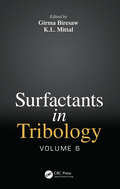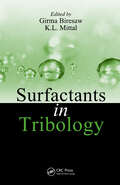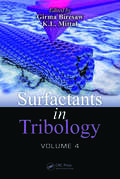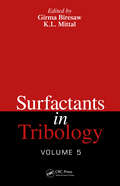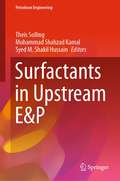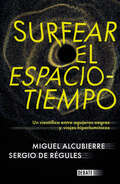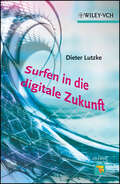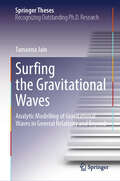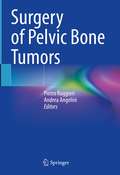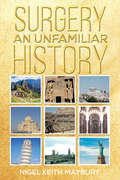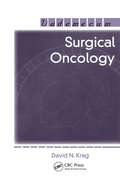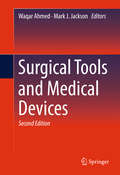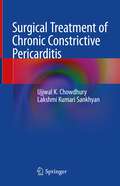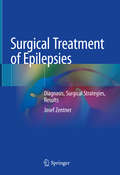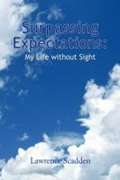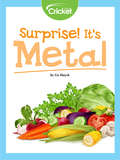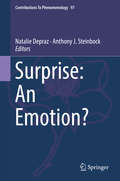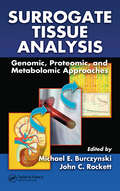- Table View
- List View
Surfactants in Tribology
by K. L. Mittal Girma BiresawSurfactants play a critical role in Tribology controlling friction, wear, and lubricant properties such as emulsification, demulsification, bioresistance, oxidation resistance, rust prevention and corrosion resistance. This is a critical topic for new materials and devices particularly those built at the nanoscale. This newest volume will address important advances, methods, and the use of novel materials to reduce friction and wear. Scientists from industrial research and development (R&D) organizations and academic research teams in Asia, Europe, the Middle East and North America will participate in the work.
Surfactants in Tribology, Volume 1
by K. L. Mittal Girma BiresawSurfactants play a variety of critical roles in tribology. In addition to controlling friction and wear, they also allow for control of a wide range of properties of lubricants, such as emulsification/demulsification, bioresistance, oxidation resistance, and rust/corrosion prevention. This book explains recent advances in the role of surfactants wi
Surfactants in Tribology, Volume 2
by K. L. Mittal Girma BiresawThe premier symposium on Surfactants in Tribology, held in Seoul in 2006, was an enormously successful event that generated a high level of interest in the topic, leading to the publication of the first volume in this series in 2008. The tremendous response was echoed at the follow-up symposium in Berlin that same year, and leading researchers, man
Surfactants in Tribology, Volume 3
by Girma Biresaw Kashmiri Lal MittalThe manufacture and use of almost every consumer and industrial product rely on application of advanced knowledge in surface science and tribology. These two disciplines are of critical importance in major economic sectors, such as mining, agriculture, manufacturing (including metals, plastics, wood, computers, MEMS, NEMS, appliances), construction
Surfactants in Tribology, Volume 4
by K. L. Mittal Girma BiresawSurface science and tribology play very critical roles in many industries. Manufacture and use of almost all consumer and industrial products rely on the application of advanced surface and tribological knowledge. The fourth in a series, Surfactants in Tribology, Volume 4 provides an update on research and development activities connecting surfacta
Surfactants in Tribology, Volume 5
by K. L. Mittal Girma BiresawSurfactants play a critical role in Tribology controlling friction, wear, and lubricant properties such as emulsification, demulsification, bioresistance, oxidation resistance, rust prevention and corrosion resistance. This is a critical topic for new materials and devices particularly those built at the nanoscale. This newest volume will address tribological properties of cutting fluids, lubricant performance related to steel surfaces, biolubricants, and novel materials and ways to reduce friction and wear. Scientists from industrial research and development (R&D) organizations and academic research teams in Asia, Europe, the Middle East and North America will participate in the work.
Surfactants in Upstream E&P (Petroleum Engineering)
by Theis Solling Muhammad Shahzad Kamal Syed M. Shakil HussainThis edited book explores the use of surfactants in upstream exploration and production (E&P). It provides a molecular, mechanistic and application-based approach to the topic, utilising contributions from the leading researchers in the field of organic surfactant chemistry and surfactant chemistry for upstream E&P. The book covers a wide range of problems in enhanced oil recovery and surfactant chemistry which have a large importance in drilling, fracking, hydrate inhibition and conformance. It begins by discussing the fundamentals of surfactants and their synthesis. It then moves on to present their applicability to a variety of situations such as gas injections, shale swelling inhibition, and acid stimulation. This book presents research in an evolving field, making it interesting to academics, postgraduate students, and experts within the field of oil and gas.
Surfear el espacio-tiempo: Un cientifico entre agujeros negros y viajes hiperlumínicos
by Sergio De Régules Miguel Alcubierre«Si un día se encuentran a Albert Einstein en un elevador, huyan…» Un día, Miguel estaba viendo Star Trek cuando, de pronto, se le ocurrió cómo revolucionar la teoría de la relatividad y viajar más rápido que la luz… La anécdota, que parece sacada de The Big Bang Theory, es completamente real. La protagonizó un joven mexicano cuando estudiaba su doctorado en Cardiff. Este libro cuenta aquel momento, pero —más interesante aún— relata la ciencia que hay detrás de esa posibilidad, de aquellateoría de Einstein y de algunos de los postulados más espléndidos de la astrofísica. Surfear el espacio-tiempo también explica las investigaciones que vinieron después: algo incluso más importante que aquella «revelación». De la mano del divulgador Sergio de Régules, Miguel Alcubierre —actualmente uno de los científicos más importantes de Latinoamérica— nos cuenta de su vida y, con ella, la pasión infinita de indagar en las ondas gravitacionales, los agujeros negros y otros enigmas del universo.
Surfen in die digitale Zukunft (Erlebnis Wissenschaft)
by Dieter LutzkeWe are surrounded by digital music, digital pictures, digital videos - and soon by digital wallpapers. Experience how the digits zero and one changed technology and therefore revolutionized our life.
Surfing the Gravitational Waves: Analytic Modelling of Gravitational Waves in General Relativity and Beyond (Springer Theses)
by Tamanna JainThis book discusses the construction of analytical waveform models within the EOB formalism for a specific alternative theory of gravity, the so-called massless scalar-tensor theory. More specifically, authors describe the map of the dynamics of a binary system in scalar-tensor theory into the EOB formalism by building upon the PN expanded Lagrangian of the two-body problem at 3PN order. Authors discuss the generalization of the 2PN EOB Hamiltonian to 3PN order for the conservative part of the dynamics and then compute the scalar-tensor corrections to EOB potentials for generic orbits. Authors also compute the corrections in the EOB Hamiltonian due to tidal effects at 3PN order for circular orbits. Following this, authors describe the derivation of the angular momentum flux in the scalar-tensor theory for both the scalar part and the tensorial part up to 1PN and 1.5PN order, respectively. Authors then use these results along with the energy flux to compute generic orbit radiation reaction effects in the EOB formalism up to 1PN order. Finally, authors use the 3PN conservative dynamics results in the EOB formalism to derive the scattering angle in the scalar-tensor theories, which can be used in future as a check against the scattering angle computed using scattering amplitude techniques. Finally, authors implement up to 3PN conservative dynamics results in the EOB-based waveform model TEOBResumS. Additionally, authors investigate the improvement in the inference of the properties of neutron stars using the information of the observation of electromagnetic counterparts of the GW signal GW170817 and improved fits of the threshold mass. The application of the improved fits to the GW170817 signal implies that a significant part of the parameter space is not supported by the observation of the EM counterpart, implying improved constraints on the neutron star radii and hence the equation-of-state.
Surgery of Pelvic Bone Tumors
by Pietro Ruggieri Andrea AngeliniApproaches to complex pelvic surgery have changed dramatically in recent years thanks to the development of the entire field of orthopedic surgery. This volume focuses on the mastery of diagnosis, management and operative techniques for tumors of the pelvis. It also provides a thorough understanding of how to select the best procedure, how to avoid complications, and what outcomes to expect. Written by experts from leading institutions around the globe, it is a comprehensive reference on treating the full range of musculoskeletal tumors frequently encountered in the pelvis. It offers an overview and an update on the epidemiology, principles of initial assessment, clinical presentation and imaging characteristics of pelvic tumors, guiding clinicians through key questions for developing a differential diagnosis and selecting the appropriate surgical technique. This book is an indispensable resource for orthopedists, oncologists, as well as radiologists and pathology specialists treating patients with bone and soft-tissue tumors.
Surgery: An Unfamiliar History
by Nigel Keith MayburyThis is a fascinating account of surgery that throws light on forgotten and unknown aspects of its practice from antiquity to the present. It illuminates the rare periods of progress and also explains why there were lengthy times when no original operations were undertaken. Maybury has achieved this by identifying the time and place when each operation was first undertaken. The first of these was the trephination of the skull in Peru twelve thousand years ago, presumably to exorcise evil spirits. This operation over several thousand years reached Europe where Hippocrates described and rationalised it to treat head injuries, it is still practiced today and is the forerunner of each subsequent original operation. The golden ages of surgery took place in Ancient Greece and India and 1,300 years later in Western Europe and the USA. Between these periods, no original operations took place. Maybury explains why this happened and reveals the Greek theory that dominated surgery for over 2,000 years. He describes the passage and translation of the Greek manuscripts and their acceptance in the Arabian Empires and how in turn the Arabic versions strongly influenced Italy and then Western Europe. He also tells of the Edict of Tours of 1163 that devastated surgery and took 700 years to rectify and also the extraordinary modern era when all the tissues of the body were finally operated upon and very much more.
Surgical Critical Care Vivas
by Mazyar KananiAn understanding of how to manage patients in the critical care environment is a key objective of surgical training, and the MRCS viva voce examination remains an area of much anxiety for many candidates. Surgical Critical Care Vivas aims to dispel at least some of this anxiety by providing some of the most common questions that are likely to be encountered, along with detailed model answers, which help the reader to consolidate their knowledge and understand key concepts. The answers themselves are structured so that the main points needed to address the question fully are clearly summarised and easily understood. Packed with useful information presented in an accessible A-Z format, this useful book allows the busy candidate to work through any number of questions, alone or as part of a group, to practice their oral examination technique, focus on areas of weakness and most effectively plan their revision. Essential reading for MRCS/AFRCS(Ed) viva examination candidates. Also useful as an aide memoire to the junior surgeon and anaesthetist and as a quick reference and self-assessment tool for other ICU-based personnel such as emergency nurses or operating department assistants.
Surgical Oncology
by David N. KragThis book meets the information needs of the medical student or surgical resident rotating on a surgical service which emphasizes oncology. It is also useful for the practicing general surgeon in reviewing the most current information on organ specific cancer therapy. It is not designed to be encyclopedic but distills important information about surgical oncology in a concise, up-to-date, and readable manner.
Surgical Strategies in Endourology for Stone Disease
by David M. Albala Sanchia S. Goonewardene Raymond J. Leveillee Karen Ventii Ali GharibThis book provides a practical guide to surgical endourology. Evidence-based chapters give expert opinion on complex cases, best practice techniques, and treating complications. The book covers a broad range of topics required within urological treatment including basic science, imaging in endourology, the use of technological devices, therapeutics for endourology, the treatment of high risk patients, stone disease management, pelvic kidneys, and dialysis. Surgical Strategies in Endourology aims to give the reader guidance in treating patients with endourological conditions and is relevant to both practising and trainee urologists.
Surgical Tools and Medical Devices
by Mark J. Jackson Waqar AhmedThis new edition presents information and knowledge on the field of biomedical devices and surgical tools. The authors look at the interactions between nanotechnology, nanomaterials, design, modeling, and tools for surgical and dental applications, as well as how nanostructured surfaces can be created for the purposes of improving cell adhesion between medical devices and the human body. Each original chapter is revised in this second edition and describes developments in coatings for heart valves, stents, hip and knee joints, cardiovascular devices, orthodontic applications, and regenerative materials such as bone substitutes. There are also 8 new chapters that address:Microvascular anastomosesInhaler devices used for pulmonary delivery of medical aerosolsSurface modification of interference screwsBiomechanics of the mandible (a detailed case study)Safety and medical devicesThe synthesis of nanostructured materialDelivery of anticancer molecules using carbon nanotubesNano and micro coatings for medical devicesThis book is appropriate for engineers, material scientists, chemists, physicists, biologists, medical and dental professionals with an interest in biomedical devices and tools, and researchers in the same fields.
Surgical Treatment of Chronic Constrictive Pericarditis
by Ujjwal K. Chowdhury Lakshmi Kumari SankhyanThis book provides comprehensive information and clarity on all aspects of diagnosing and managing constrictive pericarditis. The operative procedures for constrictive pericarditis are presented in detail with technical tips supplemented by surgical videos. Further, it explores and guides on issues with mixed opinions like the role of corticosteroids, timing of the operation, choice of the operative procedure, terminologies to describe the extent of decortication, and the requirement of cardiopulmonary bypass. Despite experience spanning over 100 years, there is no fool-proof formula in the published literature that can be used in selecting an optimal surgical approach for a given patient. The terms "radical", "total", "extensive", "complete", "subtotal", "adequate", "near-total" and "partial" pericardiectomy also have been variably used in the literature, often without a precise definition of the limits of pericardial resection.Providing an update on the latest advancements and long-term results of pericardiectomy appeals to all clinicians managing constrictive pericarditis. For the trainees, it offers insights into surgical techniques' relevant anatomy and foundation. The book will be beneficial to MBBS, MD, MS, M.Ch (CTVS), DM (Cardiology), Diplomate of National Board (Cardiology and CTVS), FRCS, FRACS, MD (USA, Canada, and in all developing and developed countries).
Surgical Treatment of Epilepsies: Diagnosis, Surgical Strategies, Results
by Josef ZentnerThis book fills the gap between the increasing demand for epilepsy surgical experience and limited training facilities in this area. It comprehensively describes surgical techniques, including tricks and pitfalls, based on the author’s 30 years of experience, providing optimal and effective training for young neurosurgeons by avoiding learning by trial and error. Moreover, it also includes useful information for epileptologists and other professionals involved in the epilepsy surgical program to allow them to gain a better understanding of possibilities and limitations of epilepsy surgery.
Surpassing Expectations: My Life without Sight
by Lawrence ScaddenThe booktells the story of the author's life without sight,a memoir that recalls the activities that brought him international acclaim as a scientist, policymaker, and advocate.
Surprise! It's Metal
by Liz HuyckFrom water, to paint, to breakfast cereal, who could have guessed that all of these things have metal in them? There's metal all around! This story includes a fun experiment to pull iron out of cereal.
Surprise: An Emotion? (Contributions To Phenomenology #97)
by Natalie Depraz Anthony J. SteinbockThis volume offers perspectives on the theme of surprise crossing philosophical, phenomenological, scientific, psycho-physiology, psychiatric, and linguistic boundaries. The main question it examines is whether surprise is an emotion. It uses two main theoretical frameworks to do so: psychology, in which surprise is commonly considered a primary emotion, and philosophy, in which surprise is related to passions as opposed to reason. The book explores whether these views on surprise are satisfying or sufficient. It looks at the extent to which surprise is also a cognitive phenomenon and primitively embedded in language, and the way in which surprise is connected to personhood, the interpersonal, and moral emotions. Many philosophers of different traditions, a number of experimental studies conducted over the last decades, recent works in linguistics, and ancestral wisdom testimonies refer to surprise as a crucial experience of both rupture and openness in bodily and inner life. However, surprise is a theme that has not been dealt with directly and systematically in philosophy, in the sciences, in linguistics, or in spiritual traditions. This volume accomplishes just that.
Surprising Animal Senses (F&P Benchmark Assessment System 1 #Level K, Nonfiction)
by India RubySurprising Animal Senses Author: India Ruby
Surrogate Humanity: Race, Robots, and the Politics of Technological Futures (Perverse Modernities: A Series Edited by Jack Halberstam and Lisa Lowe)
by Kalindi Vora Neda AtanasoskiIn Surrogate Humanity Neda Atanasoski and Kalindi Vora trace the ways in which robots, artificial intelligence, and other technologies serve as surrogates for human workers within a labor system entrenched in racial capitalism and patriarchy. Analyzing myriad technologies, from sex robots and military drones to sharing-economy platforms, Atanasoski and Vora show how liberal structures of antiblackness, settler colonialism, and patriarchy are fundamental to human---machine interactions, as well as the very definition of the human. While these new technologies and engineering projects promise a revolutionary new future, they replicate and reinforce racialized and gendered ideas about devalued work, exploitation, dispossession, and capitalist accumulation. Yet, even as engineers design robots to be more perfect versions of the human—more rational killers, more efficient workers, and tireless companions—the potential exists to develop alternative modes of engineering and technological development in ways that refuse the racial and colonial logics that maintain social hierarchies and inequality.
Surrogate Tissue Analysis: Genomic, Proteomic, and Metabolomic Approaches
by Michael E. Burczynski John C. RockettBoth an introduction and a fundamental reference, this book explores how to apply genomic, proteomic, and metabolomic technologies to surrogate tissue analysis. It reviews fundamental analytical issues and actual initial results generated using these technologies. The book covers transcriptional profiling (genomics), protein profiling (proteomics), methylation profiling (epigenomics), metabolite profiling (metabolomics) and additional biomarker identification methods that can be applied to surrogate tissues. This book is useful to researchers and scientists interested in applying novel methodologies for identifying biomarkers in the fields of pharmacology, toxicology, and medicine.
